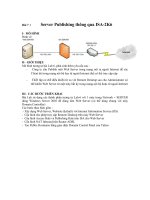vsp 41 esxi server config
Bạn đang xem bản rút gọn của tài liệu. Xem và tải ngay bản đầy đủ của tài liệu tại đây (2.22 MB, 224 trang )
ESXi Configuration Guide
ESXi 4.1
vCenter Server 4.1
This document supports the version of each product listed and
supports all subsequent versions until the document is replaced
by a new edition. To check for more recent editions of this
document, see />
EN-000327-02
ESXi Configuration Guide
You can find the most up-to-date technical documentation on the VMware Web site at:
/>The VMware Web site also provides the latest product updates.
If you have comments about this documentation, submit your feedback to:
Copyright © 2009–2011 VMware, Inc. All rights reserved. This product is protected by U.S. and international copyright and
intellectual property laws. VMware products are covered by one or more patents listed at
/>VMware is a registered trademark or trademark of VMware, Inc. in the United States and/or other jurisdictions. All other marks
and names mentioned herein may be trademarks of their respective companies.
VMware, Inc.
3401 Hillview Ave.
Palo Alto, CA 94304
www.vmware.com
2
VMware, Inc.
Contents
Updated Information 7
About This Book 9
1 Introduction to ESXi Configuration 11
Networking
2 Introduction to Networking 15
Networking Concepts Overview 15
Network Services 16
View Networking Information in the vSphere Client 16
View Network Adapter Information in the vSphere Client
17
3 Basic Networking with vNetwork Standard Switches 19
vNetwork Standard Switches 19
Port Groups 20
Port Group Configuration for Virtual Machines
VMkernel Networking Configuration 21
vNetwork Standard Switch Properties 24
20
4 Basic Networking with vNetwork Distributed Switches 27
vNetwork Distributed Switch Architecture 28
Configuring a vNetwork Distributed Switch 29
dvPort Groups 32
dvPorts 33
Private VLANs 34
Configuring vNetwork Distributed Switch Network Adapters 36
Configuring Virtual Machine Networking on a vNetwork Distributed Switch
Network I/O Control 40
39
5 Advanced Networking 43
Internet Protocol Version 6 43
VLAN Configuration 44
Networking Policies 44
Change the DNS and Routing Configuration 60
MAC Addresses 61
TCP Segmentation Offload and Jumbo Frames 62
NetQueue and Networking Performance 65
VMDirectPath I/O 66
VMware, Inc.
3
ESXi Configuration Guide
6 Networking Best Practices, Scenarios, and Troubleshooting 67
Networking Best Practices 67
Mounting NFS Volumes 68
Networking Configuration for Software iSCSI and Dependent Hardware iSCSI 68
Troubleshooting 71
Storage
7 Introduction to Storage 75
About ESXi Storage 75
Types of Physical Storage 76
Supported Storage Adapters 77
Target and Device Representations
About ESXi Datastores 79
Comparing Types of Storage 82
Displaying Storage Adapters 83
Viewing Storage Devices 84
Displaying Datastores 85
77
8 Configuring ESXi Storage 87
Local SCSI Storage 87
Fibre Channel Storage 88
iSCSI Storage 88
Datastore Refresh and Storage Rescan Operations 102
Create VMFS Datastores 103
Network Attached Storage 104
Creating a Diagnostic Partition 106
9 Managing Storage 109
Managing Datastores 109
Changing VMFS Datastore Properties 111
Managing Duplicate VMFS Datastores 113
Using Multipathing with ESXi 115
Storage Hardware Acceleration 123
Thin Provisioning 124
Turn off vCenter Server Storage Filters 127
10 Raw Device Mapping 129
About Raw Device Mapping 129
Raw Device Mapping Characteristics 132
Managing Mapped LUNs 134
Security
11 Security for ESXi Systems 139
ESXi Architecture and Security Features 139
4
VMware, Inc.
Contents
Security Resources and Information 146
12 Securing an ESXi Configuration 147
Securing the Network with Firewalls 147
Securing Virtual Machines with VLANs 153
Securing Virtual Switch Ports 158
Internet Protocol Security 159
Securing iSCSI Storage 163
13 Authentication and User Management 167
Securing ESXi Through Authentication and Permissions 167
About Users, Groups, Permissions, and Roles 168
Working with Users and Groups on ESXi Hosts 172
Encryption and Security Certificates for ESXi 177
14 Security Best Practices and Scenarios 185
Security Approaches for Common ESXi Deployments 185
ESXi Lockdown Mode 188
Virtual Machine Recommendations 192
Host Profiles
15 Managing Host Profiles 199
Host Profiles Usage Model 199
Access Host Profiles View 200
Creating a Host Profile 200
Export a Host Profile 201
Import a Host Profile 201
Edit a Host Profile 202
Manage Profiles 203
Checking Compliance 207
Appendix
Appendix: ESXi Technical Support Commands 211
Index 215
VMware, Inc.
5
ESXi Configuration Guide
6
VMware, Inc.
Updated Information
This ESXi Configuration Guide is updated with each release of the product or when necessary.
This table provides the update history of the ESXi Configuration Guide.
Revision
Description
EN-000327-02
In “Comparing Types of Storage,” on page 82 removed VM Cluster from supported vSphere features, and
included citation for Microsoft clustering.
EN-000327-01
Minor revisions.
EN-000327-00
Initial release.
VMware, Inc.
7
ESXi Configuration Guide
8
VMware, Inc.
About This Book
This manual, the ESXiConfiguration Guide, provides information on how to configure networking for
®
VMware ESXi, including how to create virtual switches and ports and how to set up networking for virtual
machines, VMware vMotion™, and IP storage. It also discusses configuring the file system and various types
of storage such as iSCSI and Fibre Channel. The guide provides a discussion of security features built into
ESXi and the measures that you can take to safeguard ESXi from attack. In addition, it includes a list of ESXi
technical support commands along with their VMware vSphere™ Client equivalents and a description of the
vmkfstools utility.
This information covers ESXi 4.1.
Intended Audience
This manual is intended for anyone who needs to install, upgrade, or use ESXi. The information in this manual
is written for experienced Windows or Linux system administrators who are familiar with virtual machine
technology and datacenter operations.
VMware Technical Publications Glossary
VMware Technical Publications provides a glossary of terms that might be unfamiliar to you. For definitions
of terms as they are used in VMware technical documentation, go to />
Document Feedback
VMware welcomes your suggestions for improving our documentation. If you have comments, send your
feedback to
VMware vSphere Documentation
The vSphere documentation consists of the combined VMware vCenter Server and ESXi documentation set.
Abbreviations Used in Figures
The figures in this manual use the abbreviations listed in Table 1.
Table 1. Abbreviations
Abbreviation
Description
database
vCenter Server database
datastore
Storage for the managed host
dsk#
Storage disk for the managed host
VMware, Inc.
9
ESXi Configuration Guide
Table 1. Abbreviations (Continued)
Abbreviation
Description
hostn
vCenter Server managed hosts
SAN
Storage Area Network type datastore shared between
managed hosts
tmplt
Template
user#
User with access permissions
VC
vCenter Server
VM#
Virtual machines on a managed host
Technical Support and Education Resources
The following technical support resources are available to you. To access the current version of this book and
other books, go to />Online and Telephone
Support
To use online support to submit technical support requests, view your product
and contract information, and register your products, go to
/>Customers with appropriate support contracts should use telephone support
for the fastest response on priority 1 issues. Go to
/>
10
Support Offerings
To find out how VMware support offerings can help meet your business needs,
go to />
VMware Professional
Services
VMware Education Services courses offer extensive hands-on labs, case study
examples, and course materials designed to be used as on-the-job reference
tools. Courses are available onsite, in the classroom, and live online. For onsite
pilot programs and implementation best practices, VMware Consulting
Services provides offerings to help you assess, plan, build, and manage your
virtual environment. To access information about education classes,
certification programs, and consulting services, go to
/>
VMware, Inc.
Introduction to ESXi Configuration
1
This guide describes the tasks you need to complete to configure ESXi host networking, storage, and security.
In addition, it provides overviews, recommendations, and conceptual discussions to help you understand these
tasks and how to deploy a host to meet your needs.
Before you use this information, read the Introduction to vSphere for an overview of system architecture and the
physical and virtual devices that make up a vSphere system.
This introduction summarizes the contents of this guide.
Networking
The networking information provides you with a conceptual understanding of physical and virtual network
concepts, a description of the basic tasks you need to complete to configure your ESXi host’s network
connections, and a discussion of advanced networking topics and tasks.
Storage
The storage information provides you with a basic understanding of storage, a description of the basic tasks
you perform to configure and manage your ESXi host’s storage, and a discussion of how to set up raw device
mapping (RDM).
Security
The security information discusses safeguards that VMware has built into ESXi and measures that you can
take to protect your host from security threats. These measures include using firewalls, taking advantage of
the security features of virtual switches, and setting up user authentication and permissions.
Host Profiles
This section describes the host profiles feature and how it is used to encapsulate the configuration of a host
into a host profile. This section also describes how to apply this host profile to another host or cluster, edit a
profile, and check a host’s compliance with a profile.
VMware, Inc.
11
ESXi Configuration Guide
12
VMware, Inc.
Networking
VMware, Inc.
13
ESXi Configuration Guide
14
VMware, Inc.
Introduction to Networking
2
The basic concepts of ESXi networking and how to set up and configure a network in a vSphere environment
are discussed.
This chapter includes the following topics:
n
“Networking Concepts Overview,” on page 15
n
“Network Services,” on page 16
n
“View Networking Information in the vSphere Client,” on page 16
n
“View Network Adapter Information in the vSphere Client,” on page 17
Networking Concepts Overview
A few concepts are essential for a thorough understanding of virtual networking. If you are new to ESXi, it is
helpful to review these concepts.
A physical network is a network of physical machines that are connected so that they can send data to and
receive data from each other. VMware ESXi runs on a physical machine.
A virtual network is a network of virtual machines running on a single physical machine that are connected
logically to each other so that they can send data to and receive data from each other. Virtual machines can be
connected to the virtual networks that you create when you add a network.
A physical Ethernet switch manages network traffic between machines on the physical network. A switch has
multiple ports, each of which can be connected to a single machine or another switch on the network. Each
port can be configured to behave in certain ways depending on the needs of the machine connected to it. The
switch learns which hosts are connected to which of its ports and uses that information to forward traffic to
the correct physical machines. Switches are the core of a physical network. Multiple switches can be connected
together to form larger networks.
A virtual switch, vSwitch, works much like a physical Ethernet switch. It detects which virtual machines are
logically connected to each of its virtual ports and uses that information to forward traffic to the correct virtual
machines. A vSwitch can be connected to physical switches by using physical Ethernet adapters, also referred
to as uplink adapters, to join virtual networks with physical networks. This type of connection is similar to
connecting physical switches together to create a larger network. Even though a vSwitch works much like a
physical switch, it does not have some of the advanced functionality of a physical switch.
A vNetwork Distributed Switch acts as a single vSwitch across all associated hosts on a datacenter. This allows
virtual machines to maintain consistent network configuration as they migrate across multiple hosts.
A port group specifies port configuration options such as bandwidth limitations and VLAN tagging policies
for each member port. Network services connect to vSwitches through port groups. Port groups define how a
connection is made through the vSwitch to the network. Typically, a single vSwitch is associated with one or
more port groups.
VMware, Inc.
15
ESXi Configuration Guide
A dvPort group is a port group associated with a vNetwork Distributed Switch and specifies port configuration
options for each member port. dvPort Groups define how a connection is made through the vNetwork
Distributed Switch to the network.
NIC teaming occurs when multiple uplink adapters are associated with a single vSwitch to form a team. A
team can either share the load of traffic between physical and virtual networks among some or all of its
members, or provide passive failover in the event of a hardware failure or a network outage.
VLANs enable a single physical LAN segment to be further segmented so that groups of ports are isolated
from one another as if they were on physically different segments. The standard is 802.1Q.
The VMkernel TCP/IP networking stack supports iSCSI, NFS, and vMotion. Virtual machines run their own
systems’ TCP/IP stacks and connect to the VMkernel at the Ethernet level through virtual switches.
IP storage refers to any form of storage that uses TCP/IP network communication as its foundation. iSCSI can
be used as a virtual machine datastore, and NFS can be used as a virtual machine datastore and for direct
mounting of .ISO files, which are presented as CD-ROMs to virtual machines.
TCP Segmentation Offload, TSO, allows a TCP/IP stack to emit very large frames (up to 64KB) even though
the maximum transmission unit (MTU) of the interface is smaller. The network adapter then separates the
large frame into MTU-sized frames and prepends an adjusted copy of the initial TCP/IP headers.
Migration with vMotion enables a virtual machine that is powered on to be transferred from one ESXi host to
another without shutting down the virtual machine. The optional vMotion feature requires its own license key.
Network Services
A vNetwork provides several different services to the host and virtual machines.
You can to enable two types of network services in ESXi:
n
Connecting virtual machines to the physical network and to each other.
n
Connecting VMkernel services (such as NFS, iSCSI, or vMotion) to the physical network.
View Networking Information in the vSphere Client
The vSphere Client shows general networking information and information specific to network adapters.
Procedure
1
Log in to the vSphere Client and select the host from the inventory panel.
2
Click the Configuration tab and click Networking.
3
(Optional) Choose the type of networking to view.
Option
Description
Virtual Switch
Displays vNetwork Standard Switch networking on the host.
vNetwork Distributed Switch
Displays vNetwork Distributed Switch networking on the host.
The vNetwork Distributed Switch option appears only on hosts that are connected to one or more
vNetwork Distributed Switches.
Networking information is displayed for each virtual switch on the host.
16
VMware, Inc.
Chapter 2 Introduction to Networking
View Network Adapter Information in the vSphere Client
For each physical network adapter on the host, you can view information such as the speed, duplex, and
observed IP ranges.
Procedure
1
Log in to the vSphere Client and select the host from the inventory panel.
2
Click the Configuration tab, and click Network Adapters.
The network adapters panel shows the following information.
Table 2-1. Network Adapter Parameters
Option
Description
Device
Name of the network adapter.
Speed
Actual speed and duplex of the network adapter.
Configured
Configured speed and duplex of the network adapter.
Switch
vSwitch or vDS that the network adapter is associated with.
Observed IP ranges
IP addresses that the network adapter has access to.
Wake on LAN supported
Network adapter ability to support Wake on the LAN.
VMware, Inc.
17
ESXi Configuration Guide
18
VMware, Inc.
Basic Networking with vNetwork
Standard Switches
3
vNetwork Standard Switches (vSwitches) handle network traffic at the host level in a vSphere environment.
Use the vSphere Client to add networking based on the categories that reflect the types of network services:
n
Virtual machines
n
VMkernel
This chapter includes the following topics:
n
“vNetwork Standard Switches,” on page 19
n
“Port Groups,” on page 20
n
“Port Group Configuration for Virtual Machines,” on page 20
n
“VMkernel Networking Configuration,” on page 21
n
“vNetwork Standard Switch Properties,” on page 24
vNetwork Standard Switches
You can create abstracted network devices called vNetwork Standard Switches (vSwitches). A vSwitch can
route traffic internally between virtual machines and link to external networks.
You can use vSwitches to combine the bandwidth of multiple network adapters and balance communications
traffic among them. You can also configure a vSwitch to handle physical NIC failover.
A vSwitch models a physical Ethernet switch. The default number of logical ports for a vSwitch is 120. You
can connect one network adapter of a virtual machine to each port. Each uplink adapter associated with a
vSwitch uses one port. Each logical port on the vSwitch is a member of a single port group. Each vSwitch can
also have one or more port groups assigned to it. For information about maximum allowed ports and port
groups, see Configuration Maximums for vSphere 4.1.
When two or more virtual machines are connected to the same vSwitch, network traffic between them is routed
locally. If an uplink adapter is attached to the vSwitch, each virtual machine can access the external network
that the adapter is connected to.
VMware, Inc.
19
ESXi Configuration Guide
Port Groups
Port groups aggregate multiple ports under a common configuration and provide a stable anchor point for
virtual machines connecting to labeled networks.
Figure 3-1. vNetwork Standard Switch Network
VM
VM
VM
VM
VM
Network
C
A
B
C
D
E
port
groups
A
vSwitch
B
C
D
E
vSwitch
virtual
Host1
Host2
Host1
Host2 physical
physical network adapters
physical network
Each port group is identified by a network label, which is unique to the current host. Network labels are used
to make virtual machine configuration portable across hosts. All port groups in a datacenter that are physically
connected to the same network (in the sense that each can receive broadcasts from the others) are given the
same label. Conversely, if two port groups cannot receive broadcasts from each other, they have distinct labels.
A VLAN ID, which restricts port group traffic to a logical Ethernet segment within the physical network, is
optional. For a port group to reach port groups located on other VLANs, the VLAN ID must be set to 4095. If
you use VLAN IDs, you must change the port group labels and VLAN IDs together so that the labels properly
represent connectivity.
Port Group Configuration for Virtual Machines
You can add or modify a virtual machine port group from the vSphere Client.
The vSphere Client Add Network wizard guides you through the tasks to create a virtual network to which
virtual machines can connect, including creating a vSwitch and configuring settings for a network label.
When you set up virtual machine networks, consider whether you want to migrate the virtual machines in the
network between hosts. If so, be sure that both hosts are in the same broadcast domain—that is, the same Layer
2 subnet.
ESXi does not support virtual machine migration between hosts in different broadcast domains because the
migrated virtual machine might require systems and resources that it would no longer have access to in the
new network. Even if your network configuration is set up as a high-availability environment or includes
intelligent switches that can resolve the virtual machine’s needs across different networks, you might
experience lag times as the Address Resolution Protocol (ARP) table updates and resumes network traffic for
the virtual machines.
Virtual machines reach physical networks through uplink adapters. A vSwitch can transfer data to external
networks only when one or more network adapters are attached to it. When two or more adapters are attached
to a single vSwitch, they are transparently teamed.
20
VMware, Inc.
Chapter 3 Basic Networking with vNetwork Standard Switches
Add a Virtual Machine Port Group
Virtual machine port groups provide networking for virtual machines.
Procedure
1
Log in to the vSphere Client and select the host from the inventory panel.
2
Click the Configuration tab and click Networking.
3
Select the Virtual Switch view.
vSwitches appear in an overview that includes a details layout.
4
On the right side of the page, click Add Networking.
5
Accept the default connection type, Virtual Machines, and click Next.
6
Select Create a virtual switch or one of the listed existing vSwitches and the associated physical adapters
to use for this port group.
You can create a new vSwitch with or without Ethernet adapters.
If you create a vSwitch without physical network adapters, all traffic on that vSwitch is confined to that
vSwitch. No other hosts on the physical network or virtual machines on other vSwitches can send or
receive traffic over this vSwitch. You might create a vSwitch without physical network adapters if you
want a group of virtual machines to be able to communicate with each other, but not with other hosts or
with virtual machines outside the group.
7
Click Next.
8
In the Port Group Properties group, enter a network label that identifies the port group that you are
creating.
Use network labels to identify migration-compatible connections common to two or more hosts.
9
(Optional) If you are using a VLAN, for VLAN ID, enter a number between 1 and 4094. If you are not
using a VLAN, leave this blank.
If you enter 0 or leave the option blank, the port group can see only untagged (non-VLAN) traffic. If you
enter 4095, the port group can see traffic on any VLAN while leaving the VLAN tags intact.
10
Click Next.
11
After you determine that the vSwitch is configured correctly, click Finish.
VMkernel Networking Configuration
A VMkernel networking interface is used for VMware vMotion, IP storage, and Fault Tolerance.
In ESXi, the VMkernel networking interface provides network connectivity for the ESXi host as well as handling
vMotion and IP storage.
Moving a virtual machine from one host to another is called migration. Using vMotion, you can migrate
powered on virtual machines with no downtime. Your VMkernel networking stack must be set up properly
to accommodate vMotion.
IP storage refers to any form of storage that uses TCP/IP network communication as its foundation, which
includes iSCSI, FCoE and NFS for ESXi. Because these storage types are network based, they can use the same
VMkernel interface and port group.
VMware, Inc.
21
ESXi Configuration Guide
TCP/IP Stack at the VMkernel Level
The VMware VMkernel TCP/IP networking stack provides networking support in multiple ways for each of
the services it handles.
The VMkernel TCP/IP stack handles iSCSI, NFS, and vMotion in the following ways.
n
iSCSI as a virtual machine datastore.
n
iSCSI for the direct mounting of .ISO files, which are presented as CD-ROMs to virtual machines.
n
NFS as a virtual machine datastore.
n
NFS for the direct mounting of .ISO files, which are presented as CD-ROMs to virtual machines.
n
Migration with vMotion.
n
Fault Tolerance logging.
n
Provides networking information to dependent hardware iSCSI adapters.
If you have two or more physical NICs for iSCSI, you can create multiple paths for the software iSCSI by
configuring iSCSI Multipathing. For more information about iSCSI Multipathing, see the iSCSI SAN
Configuration Guide.
NOTE ESXi supports only NFS version 3 over TCP/IP.
Set Up VMkernel Networking
Create a VMkernel network adapter for use as a vMotion interface or an IP storage port group.
Procedure
1
Log in to the vSphere Client and select the host from the inventory panel.
2
Click the Configuration tab and click Networking.
3
In the Virtual Switch view, click Add Networking.
4
Select VMkernel and click Next.
5
Select the vSwitch to use, or select Create a virtual switch to create a new vSwitch.
6
Select the check boxes for the network adapters your vSwitch will use.
Select adapters for each vSwitch so that virtual machines or other services that connect through the adapter
can reach the correct Ethernet segment. If no adapters appear under Create a new virtual switch, all the
network adapters in the system are being used by existing vSwitches. You can either create a new vSwitch
without a network adapter, or select a network adapter that an existing vSwitch uses.
22
7
Click Next.
8
Select or enter a network label and a VLAN ID.
Option
Description
Network Label
A name that identifies the port group that you are creating. This is the label
that you specify when configuring a virtual adapter to be attached to this
port group when configuring VMkernel services such as vMotion and IP
storage.
VLAN ID
Identifies the VLAN that the port group’s network traffic will use.
VMware, Inc.
Chapter 3 Basic Networking with vNetwork Standard Switches
9
Select Use this port group for vMotion to enable this port group to advertise itself to another host as the
network connection where vMotion traffic should be sent.
You can enable this property for only one vMotion and IP storage port group for each host. If this property
is not enabled for any port group, migration with vMotion to this host is not possible.
10
Choose whether to use this port group for fault tolerance logging.
11
On an IPv6-enabled host, choose whether to use IP (Default), IPv6, or IP and IPv6 networking.
This option does not appear on hosts that do not have IPv6 enabled. IPv6 configuration cannot be used
with dependent hardware iSCSI adapters.
12
Click Next.
13
Select Obtain IP settings automaticallyto use DHCP to obtain IP settings, or select Use the following IP
settingsto specify IP settings manually.
If you choose to specify IP settings manually, provide this information.
DHCP cannot be used with dependent hardware iSCSI adapters.
a
Enter the IP address and subnet mask for the VMkernel interface.
b
Click Edit to set the VMkernel Default Gateway for VMkernel services, such as vMotion, NAS, and
iSCSI.
c
On the DNS Configuration tab, the name of the host is entered by default.
The DNS server addresses that were specified during installation are also preselected, as is the
domain.
d
On the Routing tab, provide the VMkernel gateway information.
A gateway is needed for connectivity to machines not on the same IP subnet as the VMkernel. The
default is static IP settings.
e
14
15
Click OK, then click Next.
If you are using IPv6 for the VMkernel interface, select one of the following options for obtaining IPv6
addresses.
n
Obtain IPv6 addresses automatically through DHCP
n
Obtain IPv6 addresses automatically through router advertisement
n
Static IPv6 addresses
If you choose to use static IPv6 addresses, complete the following steps.
a
Click Add to add a new IPv6 address.
b
Enter the IPv6 address and subnet prefix length, and click OK.
c
To change the VMkernel default gateway, click Edit.
16
Click Next.
17
Review the information, click Back to change any entries, and click Finish.
VMware, Inc.
23
ESXi Configuration Guide
vNetwork Standard Switch Properties
vNetwork Standard Switch settings control vSwitch-wide defaults for ports, which can be overridden by port
group settings for each vSwitch. You can edit vSwitch properties, such as the uplink configuration and the
number of available ports.
Change the Number of Ports for a vSwitch
A vSwitch serves as a container for port configurations that use a common set of network adapters, including
sets that contain no network adapters at all. Each virtual switch provides a finite number of ports through
which virtual machines and network services can reach one or more networks.
Procedure
1
Log in to the vSphere Client and select the host from the inventory panel.
2
Click the Configuration tab and click Networking.
3
On the right side of the page, click Properties for the vSwitch that you want to edit.
4
Click the Ports tab.
5
Select the vSwitch item in the Configuration list, and click Edit.
6
Click the General tab.
7
Choose the number of ports that you want to use from the drop-down menu.
8
Click OK.
What to do next
Changes will not take effect until the system is restarted.
Change the Speed of an Uplink Adapter
You can change the connection speed and duplex of an uplink adapter.
Procedure
1
Log in to the vSphere Client and select the host from the inventory panel.
2
Click the Configuration tab and click Networking.
3
Select a vSwitch and click Properties.
4
Click the Network Adapters tab.
5
To change the configured speed and duplex value of a network adapter, select the network adapter and
click Edit.
6
To select the connection speed manually, select the speed and duplex from the drop-down menu.
Choose the connection speed manually if the NIC and a physical switch might fail to negotiate the proper
connection speed. Symptoms of mismatched speed and duplex include low bandwidth or no link
connectivity.
The adapter and the physical switch port it is connected to must be set to the same value, such as auto and
auto or ND and ND, where ND is some speed and duplex, but not auto and ND.
7
24
Click OK.
VMware, Inc.
Chapter 3 Basic Networking with vNetwork Standard Switches
Add Uplink Adapters
You can associate multiple adapters to a single vSwitch to provide NIC teaming. The team can share traffic
and provide failover.
Procedure
1
Log in to the vSphere Client and select the host from the inventory panel.
2
Click the Configuration tab and click Networking.
3
Select a vSwitch and click Properties.
4
Click the Network Adapters tab.
5
Click Add to launch the Add Adapter wizard.
6
Select one or more adapters from the list and click Next.
7
(Optional) To reorder the NICs into a different category, select a NIC and click Move Up and Move
Down.
Option
Description
Active Adapters
Adapters that the vSwitch uses.
Standby Adapters
Adapters that become active if one or more of the active adapters fails.
8
Click Next.
9
Review the information on the Adapter Summary page, click Back to change any entries, and click
Finish.
The list of network adapters reappears, showing the adapters that the vSwitch now claims.
10
Click Close to exit the vSwitch Properties dialog box.
The Networking section in the Configuration tab shows the network adapters in their designated order
and categories.
Cisco Discovery Protocol
Cisco Discovery Protocol (CDP) allows ESXi administrators to determine which Cisco switch port is connected
to a given vSwitch. When CDP is enabled for a particular vSwitch, you can view properties of the Cisco switch
(such as device ID, software version, and timeout) from the vSphere Client.
In ESXi, CDP is set to listen, which means that ESXi detects and displays information about the associated
Cisco switch port, but information about the vSwitch is not available to the Cisco switch administrator.
View Cisco Switch Information on the vSphere Client
When CDP is set to listen or both, you can view Cisco switch information.
Procedure
1
Log in to the vSphere Client and select the host from the inventory panel.
2
Click the Configuration tab and click Networking.
3
Click the info icon to the right of the vSwitch.
VMware, Inc.
25









